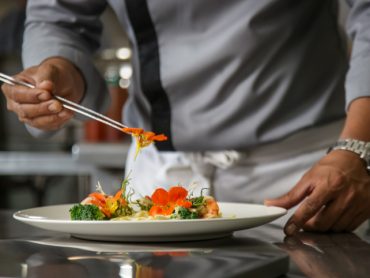Why Hotels Need a Restaurant Upgrade
Middle-of-the-road dining experiences are boring. The best restaurants serve up unique experiences that differentiate without demarcating from their host hotels.
On the surface, every hotelier has a broad notion of how integral a hotel’s food-and-beverage program can be for the guest’s onsite experience. It’s all about exciting the senses and igniting positive emotions. That, and revenue, of course.
But there have been several drastic changes to the fabric of our industry these past few years, and it’s time to revitalize the hotel-restaurant connection in order to sustain F&B profitability as well as enhance average daily rate, revenue per occupied room and loyalty sentiments.
Before we get into some specifics and a few salient examples of how to bolster the synergistic relationship between hotels and the restaurants therein, let’s gloss over the most prominent root causes for why we need change now:
- the economic recession;
- the dominance of online travel agencies;
- the rise of online restaurant information resources; and
- the passing of the torch from baby boomers to Gen Xers and millennials.
The Great Recession, which began roughly in the autumn of 2008, put a damper on the average worker’s expendable cash flow. We saw this materialize in the waning of both business and leisure traffic.
On the other side of the coin, those of us still compelled to traverse the globe saw the rise of new online resources targeting the price-conscious consumer. Why would a business guest stay at one hotel when an OTA lists rooms from a competitor across the street for two-thirds the price, especially now that the corporate expense account isn’t the pre-crash buffet it once was?
The biggest loser in all this was loyalty, which suffered equally at hotels and the restaurants housed therein. Blame Google, Yelp, Urbanspoon, OpenTable, TripAdvisor and the omnipotent networking power of social media. All these online tools make it so easy to find new, hip or highly regarded local eateries.
This can have dire consequences for hotel restaurants that aim to serve middle-of-the-road experiences. Frankly, middle of the road is boring. In the past, guests would have to contend with this because they weren’t aware of what else was in the immediate vicinity. Nowadays, they just do a quick search for more intriguing hot spots on their smartphones and then plug the address into Google Maps and go.
The traditional hotel restaurant doesn’t stand a chance.
Fueling this onslaught is the rising purchasing power of the Gen Xers and millennials, two generations wholly adept at bending electronic devices to their desire for everything cheap, fast and phenomenal. Members of these demographics dine out more often on average than their older counterparts and are more likely to have traversed the globe at a younger age—two factors lending themselves toward the development of a palate for quality cuisine.
Experiential dining
If you can offer a truly great onsite experience, nothing else matters. Guests readily will become repeat guests, and positive word of mouth will naturally flow.
Aside from excellent guest service, plush guestrooms, superb amenities, consummate cleanliness and all the other indulgences you’d expect from a “perfect” property, one of the cardinal tenets of success is to simply be different. Hotels are never purely logical points of sale. The reason certain brands can justify exorbitant nightly rates is that they provide guests with a powerful emotional experience, something that jolts them out of the monotony of day-to-day life.
This emotional journey is drawn out by activation of the senses: sight, sound, smell, taste and touch. The better you can trigger all five of these in tandem, the more likely you are to satisfy your guests’ desires and make a positive impression.
Why is the middle-of-the-road hotel restaurant model boring? Because it’s too safe and doesn’t offer anything a patron can point to as unique. Even places that feed the upscale market can fall in this trap. The scene of stark, polished furniture under sharp halogens while canned lounge music drums softly from invisible speakers is the first generalization that comes to mind.
Once you’ve been to one, you’ve been to them all. There’s no substantial jolt to the senses. No contrast. There’s nothing to subconsciously compel patrons to return to your particular restaurant over another.
This is not to say you have to think radically outside the box. In fact, a semblance of normalcy is critical, as you have to establish a baseline for customer expectations. Instead, you should strive to be similar but different, or slightly outside of a person’s comfort zone. When you aim to deliver a dining experience that is different, it can’t be all over the map. This is where the idea of congruence comes in.
All the pieces have to fit together for a common subject matter. Aiming for a themed restaurant is a step in the right direction. (Consider the standalone concepts of the Cheesecake Factory, Lone Star Texas Grill, PF Chang’s China Bistro and Johnny Rockets.) But to impart endearing memories, you must go beyond this concept by offering a higher degree of interaction with the physical space. This way, the experience in food becomes greater than the sum of all parts. People will not only remember the food they were served, the friendly banter with the waiter or certain characteristics of the ambiance, they will remember it together as one narrative clustered around the restaurant and, in turn, your property.
Examples of experiential dining
On the hunt for branded restaurants with this heightened degree of interactivity immediately made me think of Hard Rock Café, Rainforest Café and Planet Hollywood.
I still remember the time I went to Planet Hollywood and compared my palm size with that of Arnold Schwarzenegger’s imprint. It was a quick tactile distraction and yet I still remember it nearly 15 years after the fact. (My hand is bigger!)
But the above examples don’t work as viable everyday hotel partners. I consider them to be “try once” gimmicks because of their campy, vertiginous atmospheres as well as their lackluster and routine menus. None merited return trips. We need brands that possess a congruent, provocative theme built within the framework of an upscale restaurant worth revisiting.
In my search for a hotel-restaurant partnership that fits this similar-but-different paradigm I stumbled upon Johnny’s Italian Steakhouse while at a Holiday Inn in West Des Moines, Iowa. As you might guess, the place serves Italian fare and steaks, an explicit expectation by its very namesake. It demonstrated a thriving use of experiential dining principles by delivering a fascinating narrative with none of the over-the-top, bothersome kitsch of the other locales mentioned above.
What intrigued me most about Johnny’s was its distinctive supper club theme—rich velvet drapery, crystal chandeliers and a black-and-white Rat Pack photo resting above our high-back booth, while a Michael Bublé tune poured through the cool blue-lit space. It gave off a real “Mad Men” throwback vibe, which was exciting, and gave our group lots of observational topics to keep the discussion alive—especially with a nonstop playlist of hip rat pack and new traditionalist genres.
We had a lot of fun, and let me reiterate why: It’s not just about the food; it’s about the overall experience.
A synergistic relationship
My interest piqued, I reached out to the VP of brand development at Johnny’s Italian Steakhouse, Ajay Singh, to find out more about the company’s take on the hotel-restaurant relationship. Johnny’s motto is to never delineate between the restaurant and hotel. The restaurant GM collaborates daily with his hotel counterpart. As well, the same staff members who service the lounge bring their professional flare to all catered events.
It’s all too easy for seasoned hoteliers to take a laissez-faire approach to F&B, but Singh stresses this method can have toxic effects on the hotel brand. Because dining is such an emotionally charged aspect of the overall hotel narrative, a mundane or disappointing experience will reflect negatively on the property. But the opposite is also true, necessitating the imperative for quality food and service as well as investigating bold concepts like experiential dining.
The broad strokes covered, there are a few other nuanced touches worth mentioning. First, the lobby flowed into the restaurant seamlessly, allowing the music to spill out right up to the front desk and acting to subtly invite us inside. Next was the glowing blue cocktail bar, which, because of this lack of delineation, poured its neon sheen all over the surrounding floors, luring the eyes like flies to a bug zapper and making for a highly sociable space.
Point of differentiation without demarcation
One of the underlying objectives for advancing toward a synergistic relationship is to keep people in the hotel. With smartphones beckoning guests to speedily embark on an adventure beyond a property’s four walls, it’s now even more important to have straightforward and accessible twists on quotidian activities (such as eating) in order to subliminally cajole guests into better appreciating their temporary domicile.
The progression of a happy relationship often can boil down to how much time someone physically spends around a person, object or space. If guests spend five minutes in the lobby before leaving, probability dictates they will be more apathetic toward the hotel over an individual who lounges around for an hour browsing the web.
This psychological principle makes it obvious why housing an appealing restaurant will pay back tenfold. The longer guests stay at the restaurant, the more positive sentiments are transferred onto the hotel.
In order to have strong visitor appeal, your F&B experience must be a strong point of differentiation unto itself. However, as Singh points out, there’s a fine line between casual upscale dining and demarcating an eatery as a special occasion destination. You want your restaurant to be highly pleasurable while also having quick service and approachable prices so that it isn’t classified as an outlet purely for birthdays, anniversaries, career celebrations and the like.
In order to generate lucrative numbers and a consistent turnout from hotel guests (especially on weekends where you must rely more so on leisure travel), your restaurant must have that broad appeal of the middle-of-the-road cohort while still being different and memorable.
And here you thought food was just food. But it’s time for hotels to get a restaurant upgrade. Think over the concept of experiential dining and how you can harness its power to improve overall guest satisfaction.
(Article published by Larry Mogelonsky on Hotel News Now on September 25, 2013)




